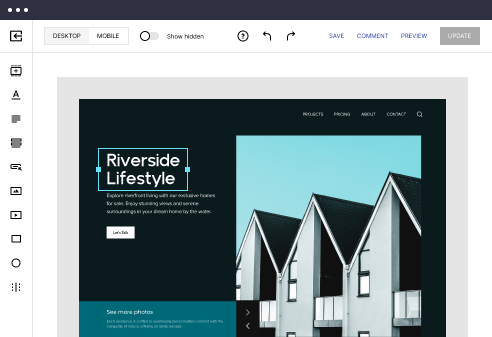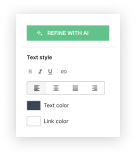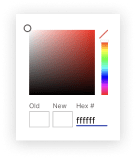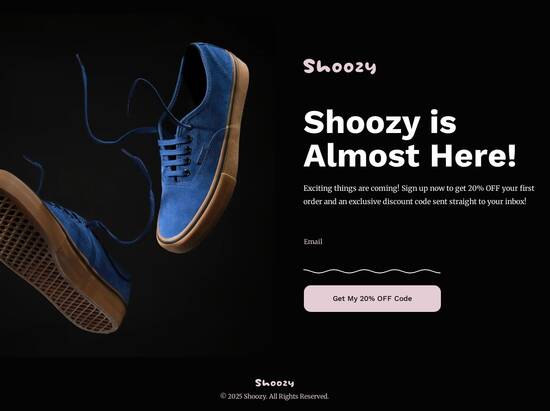
React.js optimized countdown timer page template
Explore Similar TemplatesAbout template
Supercharge your countdown timer page with React.js for outstanding performance! Learn more today.
Recommended templates
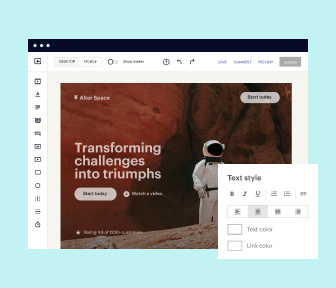
Easy to build without coding
With the intuitive drag-and-drop builder, anyone on your team can create high-converting pages without any knowledge of code or design. Make enhancements to your landing page with custom widgets using Javascript, HTML/CSS, or third-party scripts.
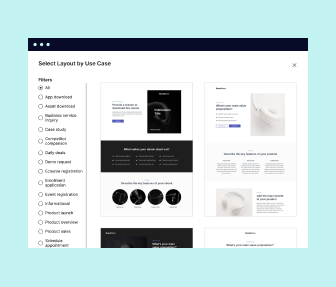
Multiple layouts for any industry and goal
Select from 500+ landing page layouts built to boost conversions across industry-specific scenarios. Customize them by adjusting fonts, adding images, and generating on-brand content with the AI assistant. Quickly scale with Instablocks® and Global Blocks that you can save, reuse, and update globally.
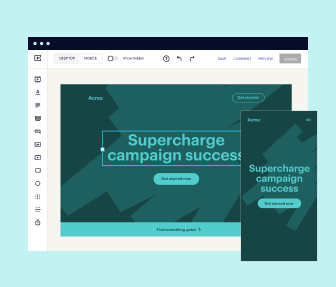
Loads fast and looks polished on any device
Every template is responsive, which means they present professionally on any device and load blazingly fast with our Thor Render Engine. You can also power them up with Google AMP technology to deliver an unparalleled mobile experience and drive higher conversions.
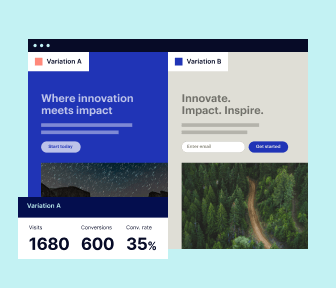
Robust analytics & experimentation
Get real-time updates and reporting across all your devices, showing the number of visitors, conversions, cost-per-visitor, and cost-per-lead. Launch AI-powered experiments, run A/B tests, and use heatmaps to analyze user behavior, then optimize your landing page to maximize conversions.

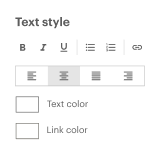
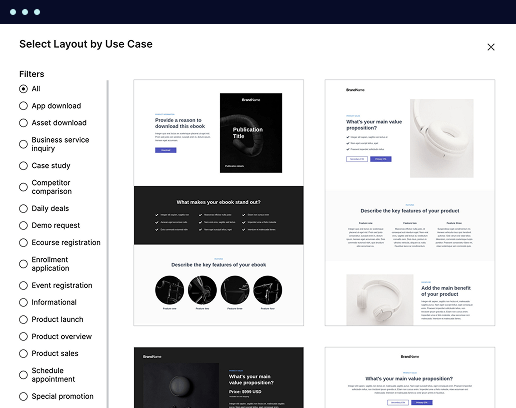
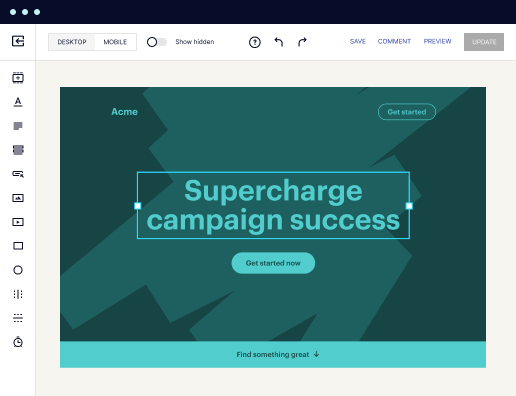
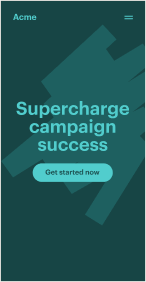
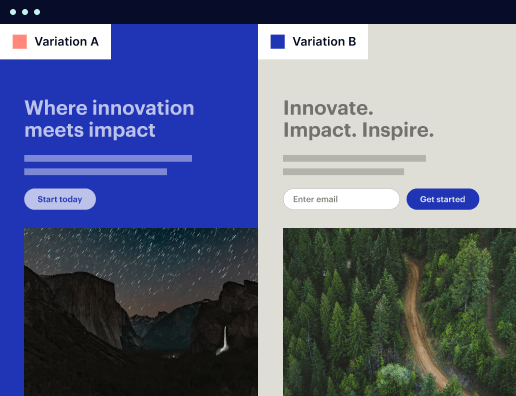

Easy to build without coding
With the intuitive drag-and-drop builder, anyone on your team can create high-converting pages without any knowledge of code or design. Make enhancements to your landing page with custom widgets using Javascript, HTML/CSS, or third-party scripts.
Multiple layouts for any industry and goal
Select from 500+ landing page layouts built to boost conversions across industry-specific scenarios. Customize them by adjusting fonts, adding images, and generating on-brand content with the AI assistant. Quickly scale with Instablocks® and Global Blocks that you can save, reuse, and update globally.
Loads fast and looks polished on any device
Every template is responsive, which means they present professionally on any device and load blazingly fast with our Thor Render Engine.
Robust analytics & experimentation
Get real-time updates and reporting across all your devices, showing the number of visitors, conversions, cost-per-visitor, and cost-per-lead. Launch AI-powered experiments, run A/B tests, and use heatmaps to analyze user behavior, then optimize your landing page to maximize conversions.
All the features you need to build react countdown timer
Explore more featuresLearn how to build cleartimeout react
Frequently asked questions about settimeout react native
Leading the way in building high-performing landing pages





React timeout: Your ultimate how-to guide
Instapage provides marketers with the most powerful landing page and conversion rate optimization tools to enhance their campaigns and maximize return on investment. By leveraging over 100 high-converting templates tailored for various industries such as marketing, education, and financial services, marketers can effectively engage their audiences and achieve tangible results.
Understanding Landing Page Essentials
A great landing page serves as the backbone of any digital marketing strategy. It's where potential customers land after clicking a link, and its effectiveness can significantly impact conversion rates. Key elements include a compelling headline, persuasive copy, and a clear call-to-action. Instapage simplifies the process by offering user-friendly templates designed to capture attention and drive user engagement.
- High-Quality Templates: Instapage's library includes diverse templates optimized for various campaigns and verticals.
- Flexible Editing Tools: User-friendly builders allow marketers to create stunning pages without needing coding skills.
- Lead Generation Elements: These pre-built components make it easy to capture leads effectively.
Step-by-Step Page Creation Process
Creating an effective landing page involves several key steps:
- Choose a Template: Start by selecting a template that aligns with your campaign's goals.
- Customize Your Page: Utilize the intuitive drag-and-drop builder to add or modify elements such as images, text, and CTAs.
- Publish and Promote: Once your page looks perfect, publish it and integrate with your marketing channels seamlessly.
Optimizing for Conversion
Optimization is crucial in turning visitors into customers. Instapage offers built-in experimentation features that help you understand how users interact with your page.
- A/B Testing: Compare different versions of your page to discover which elements drive higher conversions.
- Heatmaps: Use heatmaps to see where users click most, helping you refine your design.
- Analytics Dashboard: Track page performance and make data-driven adjustments for improved outcomes.
By following these steps and utilizing the optimization tools Instapage offers, marketers can significantly improve their lead acquisition rates.
In summary, effectively leveraging Instapage can elevate your digital marketing efforts and ensure that every aspect of your landing page works towards maximizing ROI.
Start your journey with Instapage today and unlock the potential of high-converting landing pages tailored to your unique business needs.
People also ask about react countdown timer codepen
ReactJS optimized countdown timer page template
Understanding the power of a ReactJS optimized countdown timer page template
A ReactJS optimized countdown timer page template can prove invaluable for marketing strategies, website engagement, and overall user experience. With its robust set of features and flexibility, ReactJS allows developers to create efficient and performant countdown timers that keep users informed and engaged. Such templates not only serve the core purpose of counting down to events but also contribute to a marketing plan that fosters urgency and excitement around product launches, events, or promotions.
In an era where attention is fleeting, having an engaging countdown timer can help grab and maintain user interest. Businesses across various sectors can leverage these timers for enhanced engagement, and ReactJS simplifies this process through its component-based architecture, making it a preferred choice for modern web applications.
The essence of countdown timers in digital strategies
Countdown timers serve a specific purpose in digital marketing, primarily to create urgency. By establishing a clear end time for promotions or events, businesses can drive conversions effectively. Whether it's launching a new product, announcing sales events, or promoting limited-time offers, countdowns can significantly influence consumer behavior. When users see that time is running out, their decision-making processes shift towards urgency, leading to quicker conversions.
Market insights reveal that engagement levels often spike when countdowns are in place. Studies suggest that incorporating timers can lead to up to a 30% increase in conversions. This principle is rooted in behavioral psychology, where urgency and scarcity trigger a fear of missing out (FOMO), compelling users to take swift action. Thus, using a countdown timer crafted with ReactJS not only elevates user engagement but also showcases a proactive marketing approach.
Creating urgency to increase conversions.
Applications in sales events, product launches, and promotions.
Statistical data on engagement increases through countdowns.
Behavioral psychology behind urgency and scarcity.
Crafting a visually engaging countdown timer
Creating a countdown timer that's visually striking can enhance its effectiveness. Design principles play a crucial role, where color schemes are particularly effective in evoking urgency. Colors such as red and orange tend to capture attention quickly, steering users toward action. Motion and animation can further enhance user experience; for instance, a slight pulsating effect on the timer can make it feel alive and relevant, maintaining user focus on the diminishing time.
Moreover, ensuring responsiveness across devices is vital. With a growing number of users accessing sites via mobile devices, a countdown timer must adapt fluidly to various screen sizes. Techniques such as using flexible grid layouts or media queries in CSS can aid in creating a seamless user experience, regardless of the device used. This attention to visual appeal and responsive design guarantees that the timer remains effective in drawing attention whether viewed on a desktop, tablet, or smartphone.
Technologies behind ReactJS countdown timer development
ReactJS stands out as an efficient choice for countdown timer development due to its component-based architecture. This method allows developers to build reusable UI components, ensuring that the countdown timer can be easily integrated across various sections of a website or application. Moreover, the use of Virtual DOM enhances performance. React efficiently updates only those components that change, resulting in faster rendering, which becomes particularly significant for a countdown that needs real-time updates.
When developing a countdown timer with ReactJS, various libraries can enhance functionality. For example, Moment.js can be utilized for efficient date manipulation, allowing developers to handle and display time calculations seamlessly. Additionally, libraries such as React-Router enable seamless navigation within applications, enhancing the overall experience for users as they move through different sections while staying updated on countdown progress.
Component-based architecture for scalable applications.
Virtual DOM benefits for performance optimization.
Integrating libraries such as Moment.js for date manipulation.
Utilizing libraries like React-Router for seamless navigation.
Structuring the countdown timer logic
Establishing the logic for a countdown timer includes a few core functionalities. Developers need to set up precise time calculations that ensure reliability. The countdown should account for various time zones, especially if targeted for a global audience. Additionally, handling countdown expiration alerts dynamically adds value; once the timer reaches zero, it can trigger notifications or execute specific actions, ensuring users are promptly informed about the outcome.
Customization options greatly enhance the user experience. Developers should offer users ways to personalize aspects of the countdown timer, such as styles, colors, and sound alerts. These features make the timer more engaging and adaptable to different marketing strategies. Enabling user preferences in timer settings ensures that the countdown remains relevant to their experiences, thereby fostering deeper engagement.
Enhancing user experience with real-time updates
Real-time updates serve as a cornerstone for an effective countdown timer. Leveraging state management through React hooks like `useState` and `useEffect` allows developers to track changes seamlessly in real-time. For instance, `useEffect` can be utilized to handle the countdown state and ensure the component updates efficiently as time elapses. Treating local state versus global state requires careful consideration to balance performance and maintainability, ensuring users receive real-time updates without lag.
Implementing interactive features can further improve user experience. Encouraging users to share timers or events via social media elevates engagement. Moreover, offering options for users to customize alerts and notifications can deepen their interaction with the countdown. Such features cater to a diverse user base, effectively fostering community involvement and increasing the timer's visibility across various networks.
Optimizing performance and load times
Performance optimization is crucial for any web application, particularly one utilizing a countdown timer. Implementing best practices like code splitting and lazy loading can significantly improve load times, particularly for large applications. This technique helps reduce the initial loading time by loading only the required components and resources. Additionally, optimizing images and other assets ensures that the site remains fast and responsive, which is vital in maintaining user engagement.
Moreover, enhancing SEO and usability should not be overlooked. Utilizing meta tags and schema markup ensures better visibility in search results, while accessibility guidelines enhance usability for all users. Techniques such as ensuring color contrast and keyboard navigability make the countdown timer effective for a wider audience, expanding its usability beyond just visually-centered design.
The role of community and collaboration in development
Engaging with developer communities can significantly benefit ReactJS countdown timer developments. Platforms like GitHub and Stack Overflow provide invaluable opportunities for sharing knowledge, troubleshooting issues, and collaborating on projects. By participating in these communities, developers can keep up with the latest trends and best practices, ensuring their implementations are top-notch. Standards and techniques that become popular within these forums often lead to enhanced functionality and user experience.
Moreover, adopting best practices in team collaboration is essential for ensuring quality output. Using version control methods, like Git, allows developers to track changes efficiently while conducting code reviews fosters a culture of constructive feedback. Agile methodologies enable teams to work incrementally, facilitating easy adjustments based on user feedback or changing market conditions. Collaboration forms the backbone of efficient countdown timer development, enriching the product and user experience.
Incorporating support and Q&A features
Integrating support features into the countdown timer template is crucial for enhancing customer satisfaction. Developing a structured knowledge base helps users understand the timer's features and functionalities easily. Frequently Asked Questions (FAQs) can address common queries, reducing support requests. Additionally, hosting community-driven Q&A sections facilitates peer support, creating a user-driven environment that values feedback, and encourages users to share insights.
Furthermore, establishing feedback loops enables continuous improvement. By collecting user feedback through interactive forms, developers can understand how users interact with the countdown timer and adjust accordingly. Furthermore, implementing data analytics to monitor user engagement and satisfaction metrics can inform future iterations of the product, ensuring it evolves with user needs and preferences.
Content strategy for countdown timer marketing
A well-crafted content strategy is essential for maximizing the effectiveness of a countdown timer. Engaging content, tailored to resonate with the target audience, can drive better performance. Marketers should focus on crafting compelling copy that conveys urgency and need, often employing action-driven language that prompts users to engage promptly. Additionally, utilizing visuals and video content can further illustrate the timer's benefits, creating excitement around the event or promotion.
Moreover, understanding the timing and localization aspect of marketing can significantly enhance relevance. Businesses should consider varying time zones to ensure their audience receives notifications at appropriate times. Localizing content based on user location ensures that the timer remains relevant, thereby increasing engagement rates. Overall, a comprehensive content strategy working in tandem with a countdown timer can drive substantial engagement and conversions.
Real-world applications and case studies
Numerous businesses have successfully implemented ReactJS countdown timers, showcasing transformational case studies in various sectors. For instance, an e-commerce brand that integrated countdown timers for flash sales reported a staggering 40% increase in conversions, attributing the success to the urgency created by the live timers. Additionally, businesses in the education sector that utilized timers for course registration deadlines have seen improved user engagement rates, resulting in increased enrollments.
Industry-specific applications are evident as well; event management companies can greatly benefit by incorporating countdown timers into their promotional campaigns. A comparative analysis of conversion rates before and after integration has often shown significant improvements. Unique features tailored to specific needs, such as interactive countdowns for ticket sales, provide a clear edge, showcasing how businesses effectively engage their target audience using countdown timers.
Success stories from businesses leveraging ReactJS countdown timers.
Comparative analysis of conversion rates before and after integration.
E-commerce, education, and event management showcase diverse applications.
Highlighting unique features that cater to specific industry needs.
Future trends in countdown timer development
As technology continues to evolve, the development of countdown timers is also set to change significantly. Emerging technologies like AI and machine learning are expected to play a vital role in developing predictive countdowns that estimate user actions. This novel approach can boost user engagement by providing tailored experiences based on user behavior patterns. For instance, by analyzing past interactions, a countdown might adjust itself to display reminders or alerts when users are most likely to engage.
Additionally, integrating blockchain technology could enhance secure countdown features, especially for businesses dealing with sensitive data. Furthermore, interactive enhancements through augmented reality (AR) or virtual reality (VR) experiences could provide unique user interactions with countdowns. The potential rise of automated feedback systems utilizing chatbots may further increase user interaction, streamlining communication and improving user experience.
Final thoughts on creating an impactful countdown timer page
In conclusion, developing a ReactJS optimized countdown timer page template involves understanding user needs, employing the right technologies, and creating an appealing visual design. The summary of key features including real-time tracking, responsive design, and community engagement reflects the importance of delivering a user-centered experience. Continuous learning is indispensable in adapting to technological advancements and improving tools that effectively draw user engagement.
By implementing a robust countdown timer, businesses can significantly enhance marketing strategies and drive higher conversions. Ultimately, the fusion of technological capability with user-focused design will create impactful countdown timer features that elevate digital experiences.
Ready to skyrocket conversions?
Supercharge your ad campaigns with high-performing landing pages
Get started